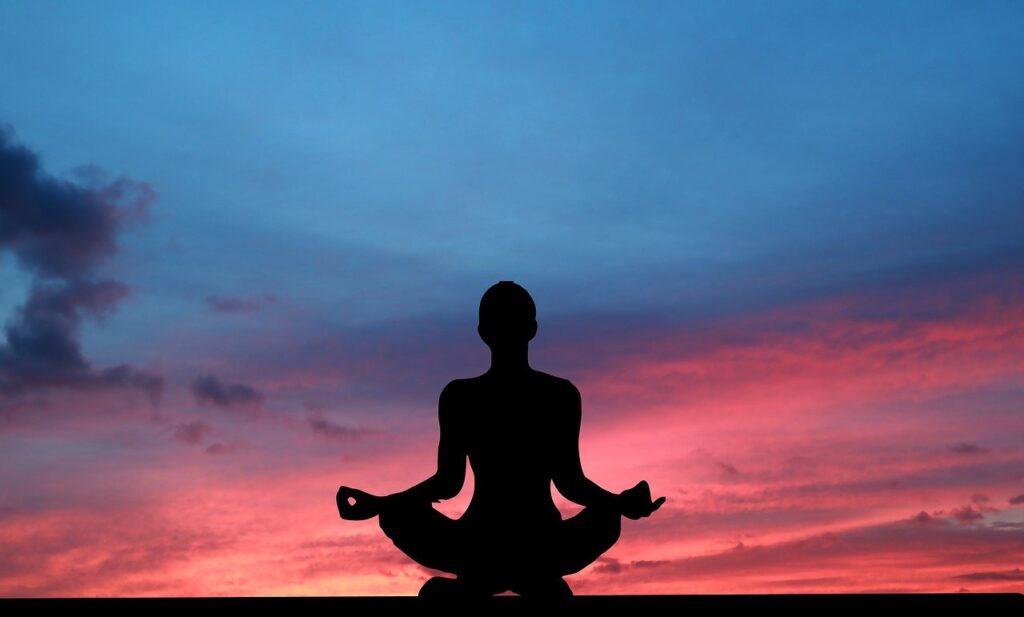The word YOGA, from the Sanskrit word ‘Yuj’, means to yoke or bind and is often interpreted as ‘UNION’ or a method of discipline. A male who practices Yoga is called a ‘Yogi’, a female practitioner, a ‘Yogini’.
There are four main paths of Yoga –
- Karma Yoga – Yoga of Action – It is the path chosen primarily by those of an outgoing nature. By detaching yourself from the fruits of your actions and offering them up to God, you learn to sublimate the ego.
- Bhakti Yoga – Yoga of Devotion or Divine Love – This path appeals particularly to those of an emotional nature. The Bhakti Yogi is motivated chiefly by the power of love and sees God as the embodiment of love.
- Raja Yoga – The Science of Physical and Mental Control – Often called the “Royal Road” it offers a comprehensive method for controlling the waves of thought by turning our mental and physical energy into spiritual energy. Raja Yoga is also called Ashtanga Yoga referring to the eight limbs leading to absolute mental control. The chief practise of Raja Yoga is meditation. When body and energy are under control meditation comes naturally.
- Jnana Yoga – Yoga of Knowledge or Wisdom – This is the most difficult path, requiring tremendous strength of will and intellect. Taking the philosophy of Vedanta the Jnana Yogi uses his mind to inquire into its own nature.
Each is suited to a different temperament or approach to life. All the paths lead ultimately to the same destination – to UNION with Brahman or God – and the lessons of each of them need to be integrated if true wisdom is to be attained. Every Yogi, or human being for that matter, possesses and identifies with each of these elements: Intellect, Heart, Body and Mind, In accordance with individual temperament and taste one can emphasize the practice of certain Yogas over others.
The Indian sage Patanjali is believed to have collated the practice of yoga into the Yoga Sutra an estimated 2,000 years ago. The Sutra is a collection of 195 statements that serves as a philosophical guidebook for most of the yoga that is practised today.

It also outlines Eight Limbs of Yoga: Ashtanga Yoga: the Yamas (restraints), Niyamas (observances), Asana (postures), Pranayama (breathing), Pratyahara (withdrawal of senses), Dharana (concentration), Dhyan (meditation), and Samadhi (absorption). As we explore these eight limbs, we begin by refining our behaviour in the outer world, and then we focus inwardly until we reach Samadhi (liberation, enlightenment).
Today mostly we associate Yoga with RAJA YOGA aiming to follow the Ashtanga Yoga. People practising yoga are engaged in the third limb, asana, which is a program of physical postures designed to purify the body and provide the physical strength and stamina required for long periods of meditation.
Yoga today is usually Hatha yoga, the physical ‘limb’ of the discipline that refers to a series of exercises and postures. It aims to unite your mind (through focus and attention), energy (through breathing exercises) and body (through movement and postures).

‘Ha’ and ‘tha’ are ‘sun’ and ‘moon’, and the practice works to balance and unite the opposites in your body, allowing energy to flow freely. The benefits can be felt physically, mentally and emotionally, from lowering blood pressure and increasing metabolism to strengthening and toning muscle. It is thought that yoga is the only way to really counteract the damage we are doing to our spines by sitting at desks all day long. The postures gently stretch muscles and joints, which not only improves flexibility but also massages glands and organs for an internal detox. Mentally, Yoga provides an opportunity to pause for a moment and be calm, to reflect and relax. It reduces levels of cortisol (stress hormone) and increases levels of dopamine and serotonin, which creates a nice chilled feeling of contentment.
Under the umbrella of Hatha Yoga, there are nine internationally recognised styles: Ashtanga, Bikram, Integral, Iyengar, Jivamukti, Kripalu, Kundalini, Sivananda and Viniyoga.
Purpose of Yoga
In his classic work the Yoga Sutras, Patanjali describes Yoga as “the progressive quieting of the fluctuations of the mind.” He then explains that through dedicated practice and the cultivation of detachment, we will stop identifying with the thoughts, feelings, and sensations that can cause us so much emotional pain—and we will open to an experience of our true self.
